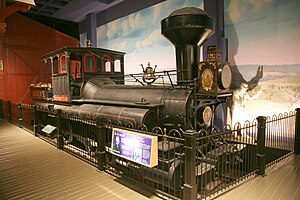0-10-0
 |
|||||||||||||||

The locomotive Reuben Wells of 1868
|
|||||||||||||||
|
|||||||||||||||
|
|||||||||||||||
|
|||||||||||||||
| Equivalent classifications | |
|---|---|
| UIC class | E |
| French class | 050 |
| Turkish class | 55 |
| Swiss class | 5/5 |
| Russian class | 0-5-0 |
| First known tank engine version | |
|---|---|
| First use | 1868 |
| Country | United States of America |
| Locomotive | Reuben Wells |
| Railway | Jeffersonville, Madison and Indianapolis Railroad |
| Designer | Reuben Wells |
| Drawbacks | Instability at speed |
| First known tender engine version | |
|---|---|
| First use | 1899 |
| Country | Austria |
| Locomotive | 180.00 class |
| Railway | Imperial Royal Austrian State Railways |
| Designer | Karl Gölsdorf |
| Drawbacks | Instability at speed |
Under the Whyte notation for the classification of steam locomotives, 0-10-0 represents the wheel arrangement of no leading wheels, ten powered and coupled driving wheels on five axles and no trailing wheels. In the United Kingdom, this type is known as a Decapod, a name which is applied to 2-10-0 types in the United States.
The lack of leading and trailing wheels makes this wheel arrangement unstable at speed, and it is a type usually confined to fairly low-speed work, such as switching (shunting), transfer runs, slow-speed drag freight, or running over mountainous terrain.
The Russian E class 0-10-0 was the most numerous single class of locomotive in the world, with around 11,000 manufactured.
In 1899, Karl Gölsdorf introduced his famous 180.00 class for the Austrian State Railway, an 0-10-0 for mountain regions which had a remarkably low axle load. It employed the Gölsdorf axle system and had the drive, unusually, on the fourth axle. The class existed both as simple expansion and as two-cylinder compound engines, and they later worked in Yugoslavia, Czechoslovakia, Romania and France.
Three 0-10-0 locomotives were owned by the Canadian Pacific Railway.
Sixteen 600 mm (1 ft 11 5⁄8 in) narrow gauge 0-10-0 locomotives, built by Baldwin Locomotive Works from 1924 to 1929, remained operational on the Yunnan-Kopei Railway until 1990.
The VR Class Vr3 0-10-0T was numbered in the range from 752 to 756 and nicknamed Rooster. The first locomotive was ordered in 1924 from Hanomag in Germany. No. 755 is stored at the Finnish Railway Museum.
...
Wikipedia
